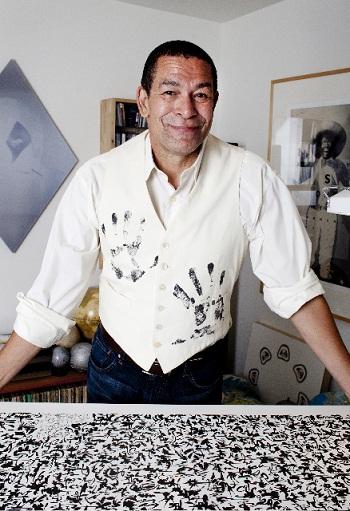Mark Steven Greenfield is an artist from Los Angeles who served as the director of the Watts Towers Art Center from 1993 until 2002. Much of his artwork deals with blackface images from the early twentieth century and other purveyors of African American stereotypes. Intern Lucas Casso recently visited him at his home/studio, where he was able to see some of his completed artworks, as well as those in progress, and he sat down with him to discuss the Watts Towers. Last year, LACMA partnered with the City of Los Angeles's Department of Cultural Affairs to develop a long-term preservation plan for Watts Towers.
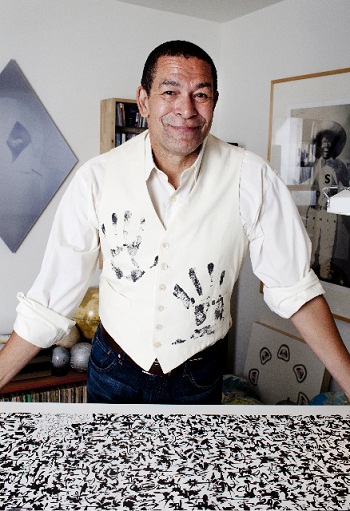
Mark Steven Greenfield, photo by Jaimie Milner
Lucas Casso: What was your first experience with the Towers, and how did that eventually translate into your connection with them?
Mark Steven Greenfield: My first memory of the Towers was actually in 1967. After the Watts rebellion, they had an art show at the Watts Summer Festival, which was very close to the Towers. I would participate in that, then I would go over and spend some time in the Towers just to visit them. I just kept coming back periodically. The City [of Los Angeles] was often working on them, so sometimes scaffolding would be up.
A friend of mine came to visit from Denmark once in the mid-1980s, and I took her out to see them. I think the significance of them really sunk in once I saw her reaction to them. She fell down on the ground and started worshipping them, and I thought, “Oh, that’s the way it works.” Then I started to look at them a little differently. At the time I was working for the police department as a police artist. I was desperate to get away from the police department. I applied for the position of arts center director through the Cultural Affairs Department, not knowing where they were going to put me. I think I had applied three times, and by the third time, they had exhausted everyone else on their list! So I was hired and they put me at the Watts Towers.
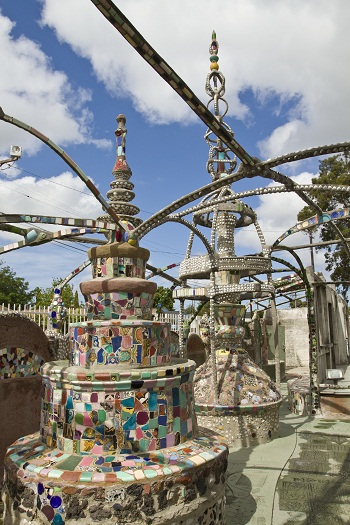
Simon Rodia’s Watts Towers, 1921–1954, photo © 2012 Museum Associates/LACMA
LC: What is it about the Towers and the Arts Center that brings people together in a way that otherwise wouldn’t happen?
MSG: I think the whole spirit of the Towers is one of the things that brings people together. I think everybody that has a creative sense knows that creation comes from little or nothing. It’s one of those things that if you’re working on paper, it’s something that you pull out of the air or out of your mind. I think you see the embodiment of that in the Towers. In so many instances they’re an inspiration to people because it was such a spontaneous type of creation. We’ve never been able to find any plans that Simon Rodia had, so each day that he approached it, he was pulling his inspiration out of the deep recesses of his mind. People can relate to that from just about anywhere.
The Annual Drum and Jazz Festivals [which take place right outside the Towers], which at this point have been going on for over thirty years, draw people from all over the country. We’ve had groups of Native Americans, groups from Sri Lanka, groups of Japanese Taiko drummers, everything you can imagine. Of course, those communities would come to support their musicians, so it wouldn’t be unusual for people from Fiji or Tahiti showing up because there was a Polynesian dance group that they wouldn’t otherwise see. Those festivals would bring people to the Towers, and then they would come back. They would tell their friends, “You should have seen these sculptures that were there! They were over a hundred feet high!” And that would make people curious.
LC: Have you, and other artists you know, been inspired by the Towers not in a literal sense, but more in a creative way?
MSG: Absolutely. The Towers radiate inspiration. You can’t be in their presence for too long without being inspired to do something—write, draw, make music. Metaphorically it’s kind of an antenna, and the creativity just zooms in on the area and spreads out all over the campus. I feel it. And that’s one of the reasons I like to go back so often. I like to go when there’s nobody there. It’s the best time, when you can just be alone with the Towers.
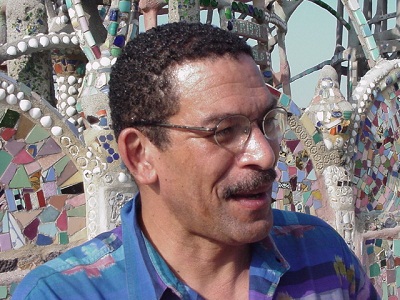
Mark Steven Greenfield in front of Simon Rodia’s Watts Towers, 1921–1954, photo © 2012 Museum Associates/LACMA
LC: Why did you continue to stay at the Towers? What did you think was your role there?
MSG: I’ve always been big on the idea of the arts supporting the quality of life. Going back to my high school days, I saw a play one time called The Day of Absence that made a real impression on me. The premise of the play is a day back in the 1960’s when all of the help, the maids and cooks, disappeared from the white community, and then the white people didn’t know how to act or do anything by themselves. And I think that play can be a metaphor for the whole idea of being in society without the arts. Without the arts, there is so much we would be missing. Whatever I can do, or whatever I would do, was always geared toward not only exposing people to more art, but trying to figure out a way to bring up a generation that would then continue on in that tradition.
The arts in most cultures of the world play a very, very important role. Much more so than in Europe, where they were decorative and, to some degree, religious. But in the rest of the world, art was always incorporated in everything they did—from tools and cooking utensils to spiritual practice and medicine, not just religion. Art was infused in all of these things in Africa, in Asia, in South America. This tradition of creativity in so many instances is being compromised now.
LC: How did your perspective on the Towers change over all the years that you were there?
MSG: It takes a while to really understand the magic of them, and I had a unique advantage of being able to see the Towers at different times of the day and night. There is a point just before sunset when light hits the Towers—you’ve never seen anything like it. I realized when I looked at the Towers up close that I think that he put most of the reflective surfaces facing west.
If it is overcast, the concrete radiates something very different. If it is a very hot day, you can almost see steam rising off the Towers. The reflective surfaces change according to the light. The Towers have a completely different character when it rains, because the concrete soaks up some of it and gets darker, so the pieces themselves are more pronounced. They change character all the time.
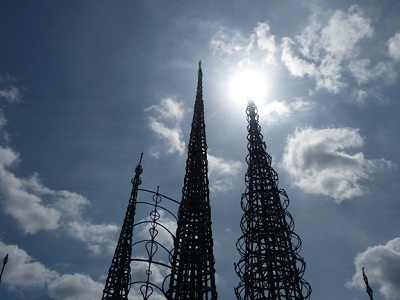
Simon Rodia’s Watts Towers, 1921–1954, photo © 2012 Museum Associates/LACMA
LC: Are there any stories that you learned or had heard about Rodia that are kind of out there?
MSG: Well, there’s a bank in there that most people don’t know about. It’s the place he used to hide his money, right next to one of the barbecue pits. Basically what he did is pour cement, put a hole in it, then put a stone in it before covering the space with more cement. So all you have to do to open it is push the stone up, but the hole is only big enough for your hand.
And then there are always people who will talk about when they would bring him some broken pottery and he would give them a penny or a cookie for each piece they would bring him. That started the whole idea of community involvement with the Towers. There are people who can point to it and say “I gave him that piece up there.” Some kids got really smart and went home and started breaking the dishes. Parents came over and said “Simon, you’ve got to stop that.” And there are people who say that never happened, but there are other people who will tell me, “I gave him some pottery and he gave me a penny!” You never really know what the truth is, but I tend to lean toward the people that say it happened.
Lucas Casso, LACMA Intern for Department of Curatorial Planning



